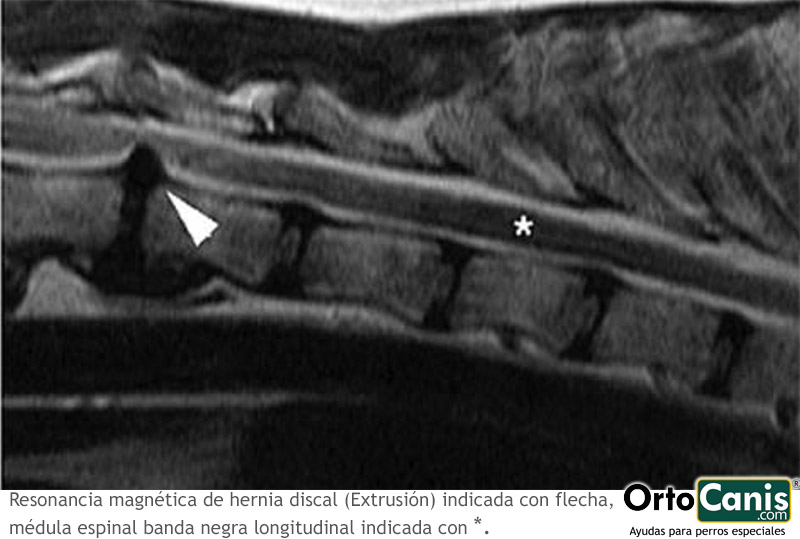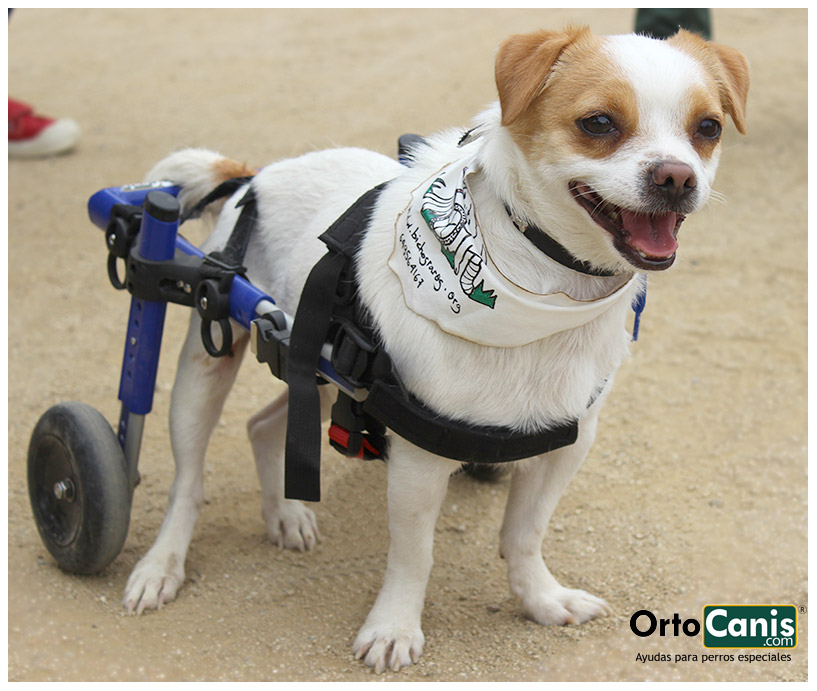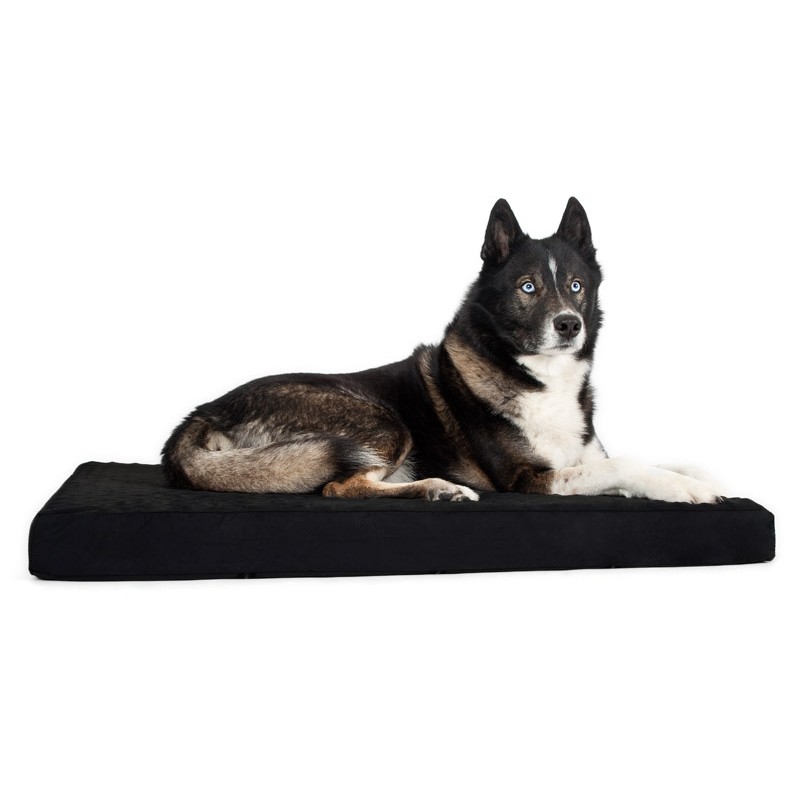Neurological causes explaining paraparesis or acute paraplegia
When your dog does not get up from the back legs, there are various possibilitiesto explain what has happened to him. And it is that this impossibility can be due to neurological, orthopedic, or systemic causes. When the cause is neurological in origin, this deficit in the locomotion of the hind legs is described as paraparesis (partial loss) or paraplegia (total loss) of motor function of the hind limbs. If it has occurred during the last 72 hours, we will speak of an acute paraplegia or paraparesis. Next we will discuss the causes that usually cause this acute paralysis in the hind limbs attributable to neurological causes.

The most common cause of paraparesis and paraplegia in dogs is degenerative invertebral disc disease</ span>which is common in dogs, but rare in cats. Specifically, type I Hansen hernias are the type of hernias that usually occur with such an acute condition, since type II tend to have a more chronic course. The breeds most predisposed to Hansen type I hernias are Dachshunds, Cockers Spaniel, Beagles, Pekingese, Lhasa Apso and Shih tzu, among others. If your dog suffers from this type of hernia, you should take him immediately to the neurologist veterinarian, as the prognosis worsens as time goes by, and it is most likely that only surgery can completely cure the animal, although satisfactory resolution is not always possible. After surgery, we can considerwww.ortocanis.com/es/content/25-que-hacer-si-tenemos-un-perro-con-una-hernia-discal "target =" _ blank ">several optionsto help improve your quality of life. If despite the acute picture, the animal is still able to walk and the veterinarian tells us that only a small protrusion of the disc has occurred, it is also possible to opt for a medical-only treatment, which includes a strict rest for 6 weeks and the supplement of combined corticosteroids. with gastric protectors, diazepam as needed and, only if the pain is severe, opioids. We will never, ever combine NSAIDs with corticosteroids, as this could cause ulcers and gastrointestinal perforations, and consequently, the death of the animal. If we decide not to operate on him, or if our partner cannot regain the mobility of the hind legs, we will assess with the veterinarian the possibility of restoring mobility thanks to a Wheelchair.
 Second, spinal cord injuries in cats and dogs are also among the leading causes of acute paraparesis or paraplegia. In these cases, a complete examination of the animal must first be carried out to check its general condition, specifically to rule out a ruptured bladder and internal bleeding, among others, that could have occurred as a result of the trauma. Likewise, systemic treatment and surgery will be offered. Treatment will always consist of total immobilization. Conservative treatment consists of immobilization and strict rest without stabilizing surgically, but this treatment is not ideal, since microfractures can occur.
Second, spinal cord injuries in cats and dogs are also among the leading causes of acute paraparesis or paraplegia. In these cases, a complete examination of the animal must first be carried out to check its general condition, specifically to rule out a ruptured bladder and internal bleeding, among others, that could have occurred as a result of the trauma. Likewise, systemic treatment and surgery will be offered. Treatment will always consist of total immobilization. Conservative treatment consists of immobilization and strict rest without stabilizing surgically, but this treatment is not ideal, since microfractures can occur.
href = "https://www.ortocanis.com/es/ayudas-tecnicas/24-colchon-ortopedico-perro.html"> As the authors of theHandbook of practical neurology *1,pos carestoppers and thepost-surgical rehabilitation are essential to ensure full recovery, as well as rest inhref = "https://www.ortocanis.com/es/ayudas-tecnicas/24-colchon-ortopedico-perro.html">soft surfaces,changing the dog's side every four to six hours so that pressure sores do not develop. We must also provide adequate nutrition and hydration, urinary catheterization if necessary every six or eight hours,style = "color: # 2c9ffd;">massagesand passive movement exercises in the hind legs for 15 minutes four times a day, swimming from the week of surgery, help you in the attempts to join, and keeping your skin dry and clean.
As the authors of theHandbook of practical neurology *1,pos carestoppers and thepost-surgical rehabilitation are essential to ensure full recovery, as well as rest inhref = "https://www.ortocanis.com/es/ayudas-tecnicas/24-colchon-ortopedico-perro.html">soft surfaces,changing the dog's side every four to six hours so that pressure sores do not develop. We must also provide adequate nutrition and hydration, urinary catheterization if necessary every six or eight hours,style = "color: # 2c9ffd;">massagesand passive movement exercises in the hind legs for 15 minutes four times a day, swimming from the week of surgery, help you in the attempts to join, and keeping your skin dry and clean.
Third, an acute paraplegia or paraparesis could be attributable to a vascular problem. Specifically, fibrocartlaginous embolism is common in dogs, although rare in cats; while aortic thromboembolism is common in cats, which would be very rare in dogs. Fibrocartlaginous embolism occurs mainly in large breeds of dogs,Although there is a predisposition in the mini Schnawzer. They produce a paraparesis or paraplegia that often occurs asymmetrically, and usually presents a hyperacute picture after intense physical exercise. Although they may present pain at the beginning of the injury, it usually disappears after a few hours. Treatment is supportive, along with corticosteroids and gastric protectors. Most dogs usually regain functionality as companion animals in about six weeks, although recovery has a different prognosis depending on the location of the injury. Regarding aortic thromboembolism, in cats, it is associated with hypertrophic cardiomyopathy. It can cause paraparesis or symmetric or asymmetric paraplegia. Treatment is complex and should be consulted in detail with a specialist, since the guidelines vary frequently.
In fourth lFurthermore, acute paralysis in the hind limbs of neurological origin may be due to an infectious disease affecting the spinal cord in dogs and cats, particularly meningomyelitis, although it is not very frequent. In addition, it is even rarer that they cause a very acute condition, since their affectation is usually more chronic. Finally, we will always have to ask ourselves if it can be a neoplastic process that has affected the spinal cord, although, as in meningomyelitis, it usually has a more chronic evolution and it would be strange to find itRare such an acute presentation that it could occur if the neoplasm causes a vertebral fracture or a spinal infarction or hemorrhage.
</ p>
Cheryl Chrisman, Christopher Mariani, Simon Platt, and Roger Clemmons. Handbook of practical neurology. 2003. Multimédica SA
Clara Castells Urgell - Veterinary Ortocanis

